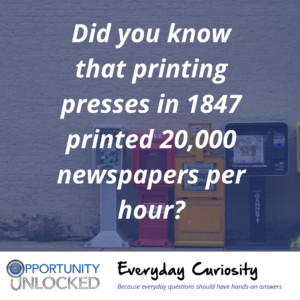 Getting information matters. One reason why the internet is so powerful is that we can find out about newsworthy events immediately as they happen. But it has not always been that way. Before the internet, most people got their news from newspapers.
Getting information matters. One reason why the internet is so powerful is that we can find out about newsworthy events immediately as they happen. But it has not always been that way. Before the internet, most people got their news from newspapers.
Newspapers need to be printed cheaply and quickly. Even though the printing press was invented in 1440, it wasn’t until the 1800s that printing technology had advanced enough to print daily newspapers. Early printing presses used a flat plate that worked a lot like a big stamp. In the 1830s, inventors started experimenting with cylindrical presses that allowed paper to roll through the machine. This technology drastically reduced the cost of newspapers, allowing publishers of the New York Sun to sell their paper for a penny an issue. The rotary printing press invented by Richard Hoe in 1847 could produce 20,000 newspapers per hour. Hoe received 24 patents between 1842 and 1874 for printing press improvements.
Modern newspapers are printed in color by creating plates for 4 separate colors (black, cyan, yellow, and magenta). Each plate is made from aluminum covered by a plastic coating. Did you know that paper can move through a modern press at nearly 25 miles per hour? Even as more and more people read news delivered over the internet, major US newspapers still circulate over 2 million copies every day.
Everyday Curiosity is a weekly magazine for kids aged 8-14 that explores math, science, and engineering. Each issue asks one big question and has three related hands-on projects to go deeper into the math, science, and engineering behind everyday observations. The projects use supplies that are already in the house or could be found easily at a grocery store, general department store, or (in rare cases) a hardware store.

Sorry, comments are closed for this post.